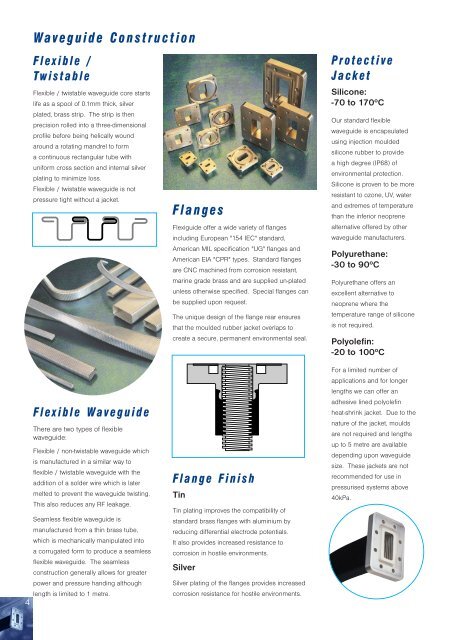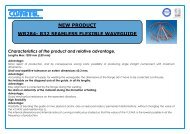Flexiguide Brochure - Arva-RF
Flexiguide Brochure - Arva-RF
Flexiguide Brochure - Arva-RF
Create successful ePaper yourself
Turn your PDF publications into a flip-book with our unique Google optimized e-Paper software.
4<br />
Waveguide Construction<br />
Flexible /<br />
Twistable<br />
Flexible / twistable waveguide core starts<br />
life as a spool of 0.1mm thick, silver<br />
plated, brass strip. The strip is then<br />
precision rolled into a three-dimensional<br />
profile before being helically wound<br />
around a rotating mandrel to form<br />
a continuous rectangular tube with<br />
uniform cross section and internal silver<br />
plating to minimize loss.<br />
Flexible / twistable waveguide is not<br />
pressure tight without a jacket.<br />
Flexible Waveguide<br />
There are two types of flexible<br />
waveguide:<br />
Flexible / non-twistable waveguide which<br />
is manufactured in a similar way to<br />
flexible / twistable waveguide with the<br />
addition of a solder wire which is later<br />
melted to prevent the waveguide twisting.<br />
This also reduces any <strong>RF</strong> leakage.<br />
Seamless flexible waveguide is<br />
manufactured from a thin brass tube,<br />
which is mechanically manipulated into<br />
a corrugated form to produce a seamless<br />
flexible waveguide. The seamless<br />
construction generally allows for greater<br />
power and pressure handing although<br />
length is limited to 1 metre.<br />
Flanges<br />
<strong>Flexiguide</strong> offer a wide variety of flanges<br />
including European "154 IEC" standard,<br />
American MIL specification "UG" flanges and<br />
American EIA "CPR" types. Standard flanges<br />
are CNC machined from corrosion resistant,<br />
marine grade brass and are supplied un-plated<br />
unless otherwise specified. Special flanges can<br />
be supplied upon request.<br />
The unique design of the flange rear ensures<br />
that the moulded rubber jacket overlaps to<br />
create a secure, permanent environmental seal.<br />
Flange Finish<br />
Tin<br />
Tin plating improves the compatibility of<br />
standard brass flanges with aluminium by<br />
reducing differential electrode potentials.<br />
It also provides increased resistance to<br />
corrosion in hostile environments.<br />
Silver<br />
Silver plating of the flanges provides increased<br />
corrosion resistance for hostile environments.<br />
Protective<br />
Jacket<br />
Silicone:<br />
-70 to 170 o C<br />
Our standard flexible<br />
waveguide is encapsulated<br />
using injection moulded<br />
silicone rubber to provide<br />
a high degree (IP68) of<br />
environmental protection.<br />
Silicone is proven to be more<br />
resistant to ozone, UV, water<br />
and extremes of temperature<br />
than the inferior neoprene<br />
alternative offered by other<br />
waveguide manufacturers.<br />
Polyurethane:<br />
-30 to 90 o C<br />
Polyurethane offers an<br />
excellent alternative to<br />
neoprene where the<br />
temperature range of silicone<br />
is not required.<br />
Polyolefin:<br />
-20 to 100 o C<br />
For a limited number of<br />
applications and for longer<br />
lengths we can offer an<br />
adhesive lined polyolefin<br />
heat-shrink jacket. Due to the<br />
nature of the jacket, moulds<br />
are not required and lengths<br />
up to 5 metre are available<br />
depending upon waveguide<br />
size. These jackets are not<br />
recommended for use in<br />
pressurised systems above<br />
40kPa.



